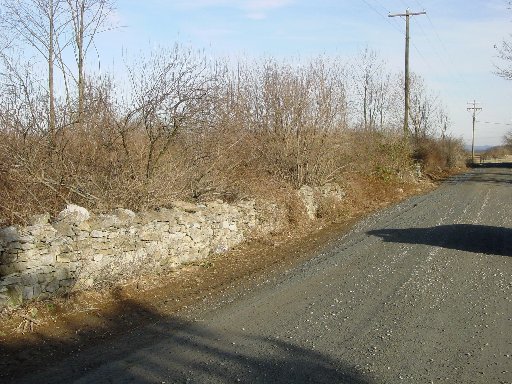
Second Winchester Part 4

Stone Wall By McCann Lane
Two Union infantry regiments, the 6th Maryland and 67th Pennsylvania, both also of McReynolds' rear guard, now moved against the Confederate left. Turning right from the Martinsburg Road down modern McCann Lane, they were somewhat protected by this stone wall as they quick-timed their way down the road.

McCann Lane
This is an over 180 degree view from along the route taken by the two Union regiments. Approaching along McCann's Lane on the left of the picture, they had turned off Martinsburg Road from the area behind the hill on the far left. The location of the Martinsburg Road further north is marked by the church and other nearby buildings behind the clearly befuddled cows on the left of the picture. Buildings more toward the center, beyond the distant and oblivious cows, mark the Charlestown Road where the Yankees were trying hard to break through.
Continuing along McCann's Lane on the right of the picture, while under artillery fire, the two Union regiments passed through the railroad underpass after a brief halt, then continued behind the cover of a small hill. Later in the battle, fleeing Yankees would escape beyond the rebel left flank through the ravine visible on the far right of the picture.

Attack of the 6th Maryland
This is the terminus of the McCann Lane, on the left of the picture, where it meets modern 662 on the center and right of the picture. Rt. 662 continues toward the main Confederate position, and the hill beyond the road (in the right-center of the picture) was the location of the six Confederate guns. The apparently abandoned house on the left, dates to the 1700s, as does the Milburn Cemetery visible behind the blue sign in the center. Men of the 67th Pa. entered the area of the farm and failed to attack, but the colonel of the 6th Maryland retained order and kept his men on the road. The 6th MD then continued into the field beyond the intersection and attacked the Confederate guns, but fell back into the ravine.
With the Federal escape along the Charlestown Road blocked,
and with the attempts on the rebel left ended in failure, there was little hope
for the Yankees. Many escaped around the Confederate flanks, including
Milroy, but a Confederate advance netted thousands of prisoners. Figures
are open to debate, but around half of the Union force was probably captured,
most of them taken across the Martinsburg Road. Twenty three guns were
part of the haul.
New to corps command, the one-legged chivalrous hen-pecked
commander
known as "Baldy" Ewell had done well, and appeared to be a worthy successor to Stonewall Jackson.
Ewell would continue the advance well into Pennsylvania, all the way to the
Susquehanna, but in just over two weeks time, he would disappoint at
Gettysburg.
Miscellaneous Notes: A few years ago, the fascinating and relatively pristine Stephenson's Depot battlefield appeared destined to become an industrial park. Efforts by preservationists prevented that, but the battlefield is still unprotected and among the most endangered of the country. The content of this section of the webpage is largely based on "The Second Battle of Winchester, June 12-15, 1863" by Charles S. Grunder, which, incidentally, is a good book that you should read.
Back to Civil War Virtual Battlefield Tours